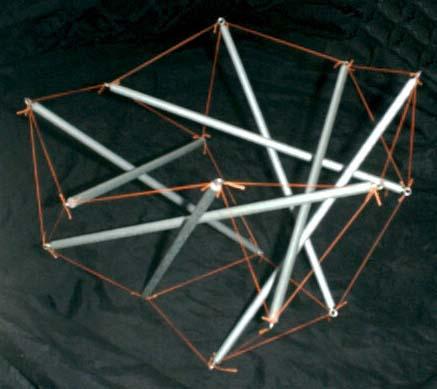

As part of the inquiries related to the Tensegrity Prism as Joint project, I looked into ways I might alter a tensegrity tetrahedron to obtain a tensegrity where all the struts are at 60° angles to each other. I didn't succeed, but one configuration suggested a flower. Having recently viewed the first episode of Yo-Yo Ma's Inspired by Bach where he collaborates with garden designer Julie Moir Messervy to create a music garden based on Bach's Cello Suite No. 1, I was in a flower kind of mood and so explored the configuration further.
The flower based on the tensegrity tetrahedron exhibited three-fold symmetry. I was interested in higher-fold symmetry, and so I explored six, five and four-fold symmetry. Seemingly intractable interference problems led me to discard the five and six-fold symmetries in favor of four-fold symmetry. This led to a structure which struck me as a tulip, hence the title of this investigation.
I completed assembly of the tulip on January 27, 2004. Having done so, I see the interference problems in the higher-fold symmetries are perhaps not so intractable if one is willing to go with a non-equi-tendoned structure. In particular, I think reducing the length of the "triten2" tendon (see the datasheet) might help the interference problem in the higher-symmetry structures. Perhaps not so coincidentally, this is the tendon with the least stress. I say "not so coincidentally" since this is not the first time I've found loosening an exceptionally tight tendon or tightening a loose one fixes up an interference problem.
A novelty in this particular project was that I incorporated the geometry of the screw-eye hubs explicitly in one of my mathematical models. Usually I assume the hubs are single points and just do an ad hoc adjustment to account for the hub geometry when it comes time to assemble the structure. I looked at the values which I would have obtained if I'd just done the ad hoc adjustment and they were all withing 0.5 mm of the results from the exact model. This was encouraging.
Just on the basis of length computation I think I'd go with the ad hoc adjustment since it's so much easier. However, I did find the detailed ray-trace "blue print" which incorporated the screw eyes was a handier guide than my usual diagram which leaves them out. A lot of the assembly process consists of anticipating how things should best be tied onto the screw eyes and having an explicit guide helped that process quite a bit.
This is also available as a VRML model.


